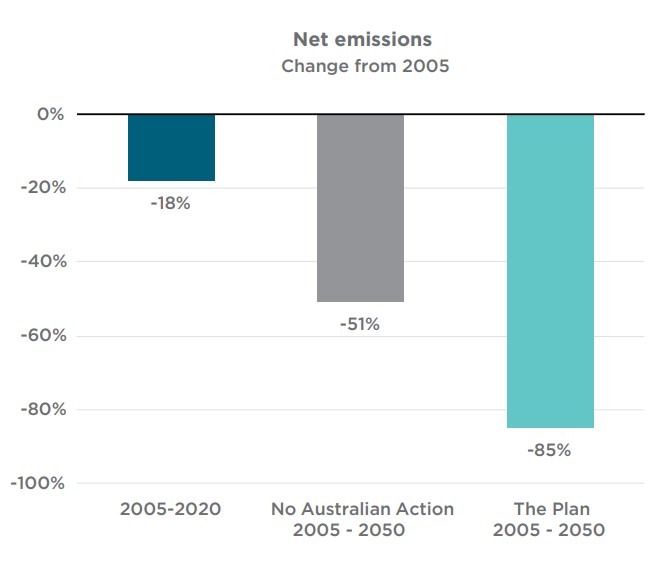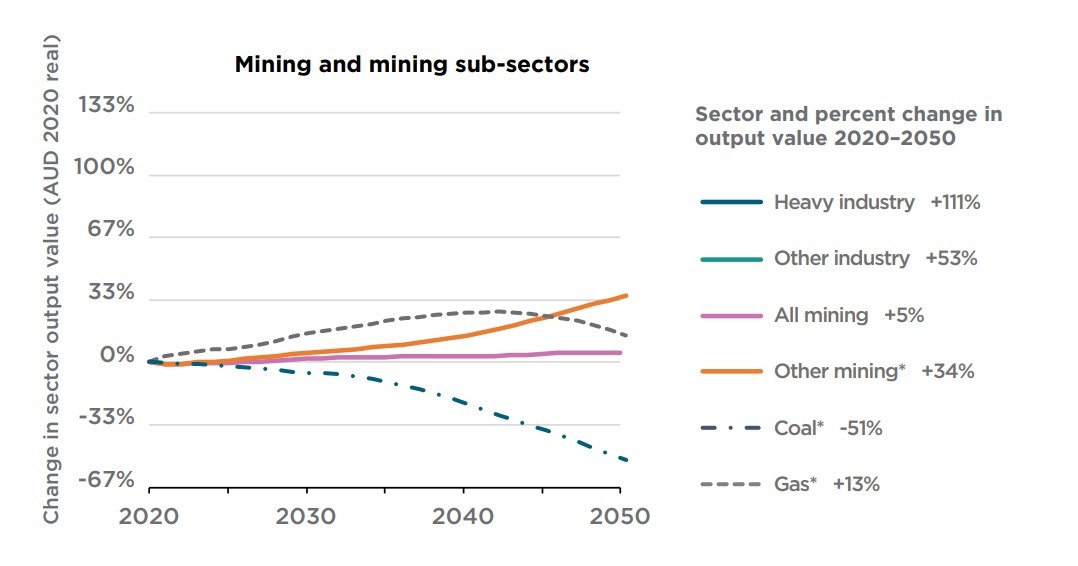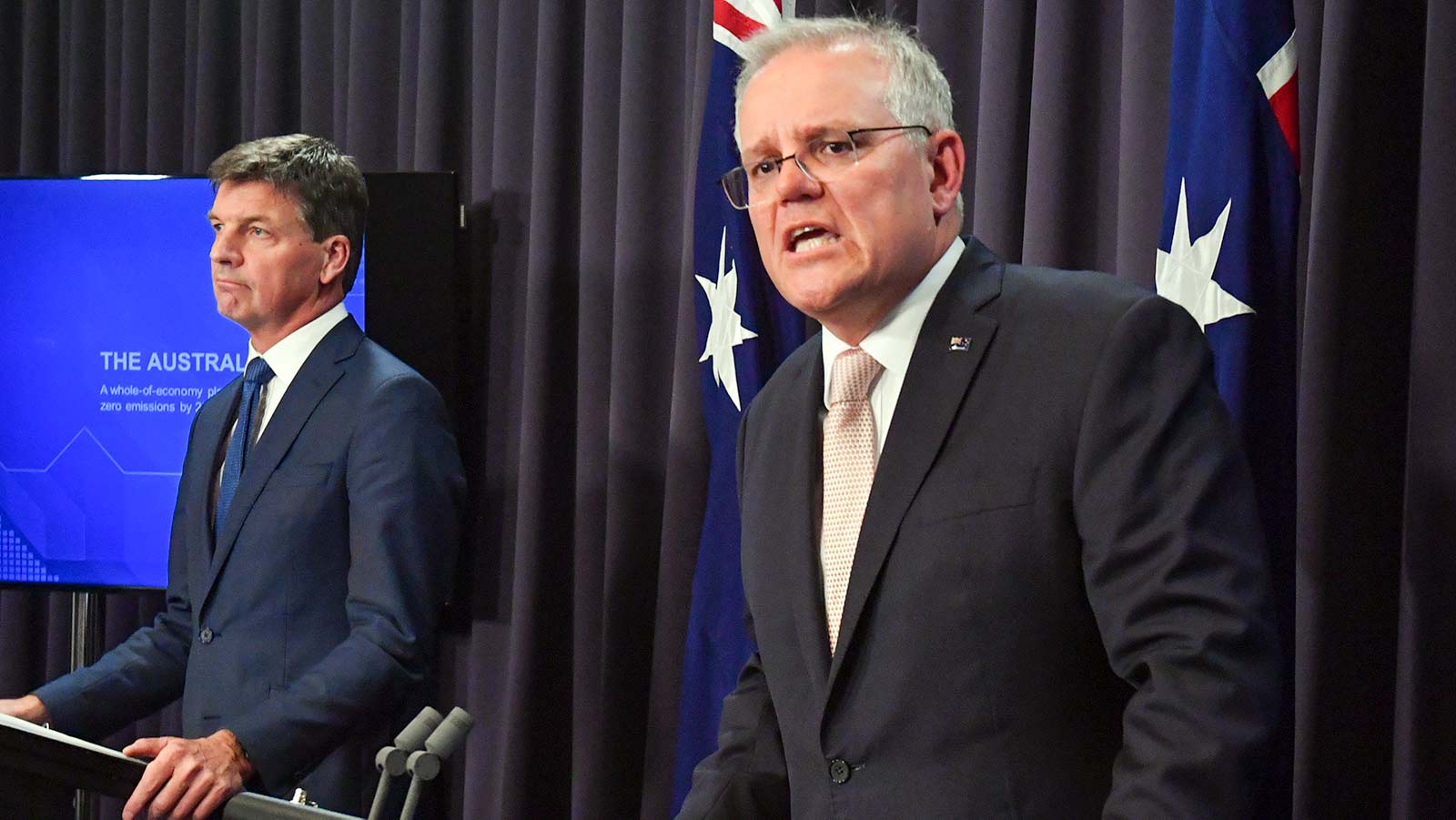The Morrison government’s modelling of its emissions reduction “plan” reveals how the government has chosen fossil fuels over farmers, how it plans to grow – not shrink – Australia’s fossil gas industry and how it fails to deliver on a claimed commitment to reaching zero net emissions by 2050.
The modelling release comes weeks after prime minister Scott Morrison announced he would commit Australia to a new 2050 target, and comes as climate talks in Glasgow head into their final hours – and where international climate groups have awarded Australia a “colossal fossil” award for its regressive policies.
It is immediately evident from the 100-page report that the Morrison government is not actually aiming to achieve net zero emissions by 2050, but instead is aiming for an 85 per cent cut in Australian emissions.

The government’s chosen path does not spell out how Australia would get to net zero emissions in 2050. Instead, a so-called “Plan” maps a path for Australia to cut domestic emissions by around 60 per cent, a further 25 per cent of Australia’s emissions being offset with credits purchased from overseas.
It leaves a remaining 15 per cent of emissions reductions – needed to actually reach net zero – to unspecified and unexpected advancements in technologies.
The plan, and the modelling that underpins it, do not detail how these advances will be achieved, merely saying that the 15 per cent gap will be bridged “through further technology breakthroughs or by overachieving abatement through existing technology priorities”.
It’s a colossal gap in detail that leaves substantial uncertainty around if and when Australia may actually reach net zero emissions.
See also: Glasgow Brief: Australia given “Colossal Fossil”; award as COP26 goes into overtime
It must also be remembered that this is modelling that Morrison, and federal energy minister Angus Taylor, used to win support from the Nationals party room for the “plan”.
The modelling highlights how the government is counting on a substantial and ongoing role for Australia’s fossil fuel industries – with the gas industry expected to grow by 13 per cent out to 2050.
While the coal sector is projected to decline in coming decades, it will still be operating at around 50 per cent of its current capacity in 2050, with Australia maintaining its position as a major global exporter of both coal and gas.
This largely stands in defiance of growing international commitments to phase the use of coal and to achieve global net zero emissions by 2050.

Revealingly, the modelling shows the Morrison government considered an alternate scenario, which evaluated the potential outcomes of Australia achieving the complete 100 per cent reduction in net emissions by 2050.
This scenario would see Australia increase its investment in domestic carbon sequestration, achieved primarily through increased re-vegetation of Australian land (and not the government’s favoured carbon capture and storage technology).
The modelling found that setting a more ambitious target – one that gets Australia all the way to full net zero by 2050 – would have a negligible impact on the Australian economy, amounting to just a 0.01 per cent change in GDP by 2050, which is meaningless for a projection three decades into the future.
The more ambitious scenario, as one might expect, has a more detrimental impact on the coal and gas sectors, with the modelling estimating that a complete net zero pathway would “have adverse impacts on fossil fuel based sectors, with $4.9 billion lower output value from coal and gas in 2050 relative to the Plan.”
Yet the modelling shows that this hit to the fossil fuel sector is almost entirely offset by increased benefits to farmers, saying that the 100 per cent net zero scenario “involves higher volumes of land sequestration, which provides $4.3 billion in additional revenue to participating land holders”.
It shows the Morrison government – and the Nationals party room – made a choice between two scenarios: adopt a “Plan” that cuts emissions by 85 per cent by 2050 and leaves the fossil fuel industry better off; or adopt a full net zero emissions target that negatively impacts the coal and gas sectors, but substantially boosts incomes for farmers, and has virtually no impact on the broader Australian economy.
As we now know, the Morrison government picked the weaker option that does not deliver net zero and that benefits fossil fuels.

The modelling has largely been prepared by the government itself, with the Department of Industry, Science, Energy and Resources leading its preparation, having engaged consultancy McKinsey – paid more than $6 million for its work – and a handful of sympathetic modellers to guide the economic analysis.
As was revealed during recent senate estimates hearings, the modelling report was still in the process of being prepared long after Morrison and Taylor announced the adoption of its “plan”.
The lack of specific details about how Australia will cut emissions over the next three decades, and the degree to which the modelling document itself is an incoherent mash of rehashed government policy announcements and economic speculation is largely reflective of how the Morrison government has approached the development of its climate and energy policies.
The modelling was released late on Friday afternoon, in a classic end of week dump designed to limit media scrutiny, and shows the degree to which the government’s emissions reduction plans lack the detail and the considered analysis that Australian businesses, investors, and environmental advocates have been calling for.
The “plan” includes no new policy initiatives. It provides no detail on how sectors like the electricity sector and industry will transition to cleaner energy sources. It contains no details around how Australia may be able to take advantage of growing global demand for zero emissions products like renewable hydrogen and green metals.
Instead, it produces a range of fanciful alternate scenarios – including one that assumes a $400 per tonne carbon price – that will clearly form the basis of political attacks against the Labor opposition, with a federal election expected to be called in coming months.
The modelling and the plan were evidently never about preparing a well-considered plan for transitioning Australia’s economy in a world rapidly moving to clean energy technologies, but it was about producing a document that could be used to convince the Nationals that the Morrison government wasn’t about to harm fossil fuel industries and to provide cover for political scare campaigns.
“It may as well have been written in crayon,” Climate Council senior researcher Tim Baxter said.
“This is pure spin. A document that has the singular purpose of attempting to legitimise the Federal Government’s do-nothing approach.”
“If this wasn’t so serious, it would be laughable but this modelling doesn’t even consider climate impacts on our economy. It assumes a heroic performance from the federal government’s pet technologies, without interrogating a single one of these wild assumptions. It downplays the potential of all other alternatives at every opportunity,” Baxter added.










